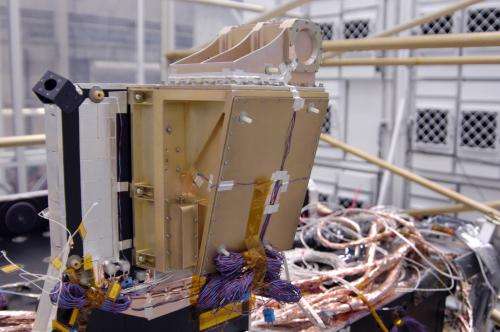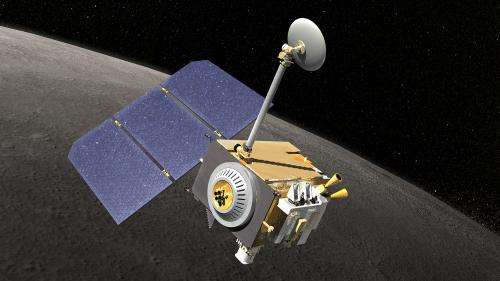NASA instrument determines hazards of deep-space radiation

Deep-space radiation is a significant danger for interplanetary human space flight. But now an instrument on NASA's Lunar Reconnaissance Orbiter (LRO) has learned more than ever before about the high-energy hazards at and around the moon. New findings from the Cosmic Ray Telescope for the Effects of Radiation (CRaTER) were published today in the journal Space Weather.
"We've never had a detector that's been as good at understanding the effects of radiation through tissue-equivalent material as the CRaTER detector," said Nathan Schwadron, CRaTER principal investigator at the University of New Hampshire, Durham. "These publications document, wall-to-wall, different effects and instrument responses with some of the best long-term measurements ever made of radiation in deep space."
Human exploration missions will rely on these measurements to know how much radiation to expect in deep space, and how best to shield against this radiation. CRaTER observes how radiation interacts with its unique tissue-equivalent plastic detector array, which mimics radiation doses within the human body. Now in an extended mission, the instrument has also encountered a few unusual sources of radiation—sources as close as the moon's surface and as vast as the cosmos itself.
Radiation in deep space comes from cosmic rays, from the solar wind and from solar energetic particles emanated during a solar storm. Particles from these sources rocket through space. Many can pass right through matter, such as our bodies. So-called ionizing radiation knocks electrons off of atoms within our bodies, creating highly reactive ions. Within Earth's protective atmosphere and magnetic field, we receive low doses of background radiation every day. The radiation hazards astronauts face are serious, yet manageable thanks to research endeavors such as the CRaTER instrument.
CRaTER measures realistic human radiation doses at the moon using a unique material called tissue-equivalent plastic (TEP). Two pieces of this plastic, roughly 2 inches and 1 inch thick, respectively, are separated by silicon radiation detectors. The TEP-detector combo measures how much radiation may actually reach human organs, which may be less than the amount that reaches the spacecraft.
"Tissue-equivalent plastic gives us an idea of the self-shielding of the body," said Larry Townsend, of the University of Tennessee, Knoxville. "The radiation spectrum at the organs is not going to be the same as the radiation spectrum that's outside the spacecraft."

Townsend notes that CRaTER's observations have come at a time when solar activity, and hence the solar wind, has been unusually quiet. The solar wind disperses some galactic cosmic rays, but in the current solar lull, more of these rays are able to bombard the Earth and moon. CRaTER, which launched aboard LRO with six other instruments in 2009, has been able to monitor the lunar environment as solar activity has declined. Further mission extensions would allow additional detailed measurements as solar activity waxes and wanes.
"They're lower-level exposures," Townsend said, of galactic cosmic rays, "but they're damaging in the sense that the particles are highly charged and heavy, and they create a lot of damage when they're going through the body."
But lab tests suggested that materials rich in hydrogen, such as some plastics, may shield against these heavy particles, said Cary Zeitlin of the Southwest Research Institute, San Antonio, Texas. "The tissue-equivalent plastic in CRaTER has fairly high hydrogen content," he said, "so it lets us test this hypothesis using data from deep space. And it turns out that plastic really is a good shield against these particles, significantly better than aluminum."
LRO's unofficial motto states that "exploration enables science, and science enables exploration." The LRO spacecraft launched as an exploration mission, a forerunner for humanity's return to the moon. But after completing its primary mission in 2010, LRO has become a powerful instrument for lunar and planetary science. CRaTER is an active participant in this scientific study, discovering a previously unmeasured source of hazardous radiation emanating from the moon itself.
This radiation comes from the partial reflection, also called an albedo, of galactic cosmic rays off the moon's surface. Galactic cosmic ray protons penetrate as much as a meter (about 3.2 feet) into the lunar surface, bombarding the material within and creating a spray of secondary radiation and a mix of high-energy particles that flies back out into space. This galactic cosmic ray albedo, which may interact differently with various chemical structures, could provide another method to remotely map the minerals present at the moon's surface.
CRaTER directly measured the proton component of the moon's radiation albedo for the first time, said Harlan Spence, deputy principal investigator at the University of New Hampshire. The TEP radiation detector measures various components of radiation separately, which enables CRaTER to, in Spence's words, "unfold" the energy spectrum of the radiation albedo. This result, he said, illustrates the value of combining exploration and science in spaceflight. "If we had been on a different science-oriented mission, we probably would've developed a different instrument," Spence said. "In fact, we probably never would have flown TEP."
Looking toward future missions, Schwadron and his colleagues are developing a next-generation radiation dose detector, drawing on CRaTER's design. The detector, called Dose Spectra from Energetic particles and Neutrons (DoSEN) builds on CRaTER's ability to break radiation down into its components and assess the doses resulting from each part of the radiation spectrum. Human exploration will benefit, Schwadron said, from this "very specific information about the spectrum of radiation we need to shield against."
Spence, who served as the instrument's principal investigator through the primary mission said he's proud of his team's foresight to equip CRaTER with the capability to accomplish its mission and continue to pursue great science.
"We had hopes and aspirations," he said, "but we didn't think we would be able to reap as much from those data as we are. Exploration now is enabling science."
More information: www.nasa.gov/lro
Provided by NASA's Goddard Space Flight Center



















